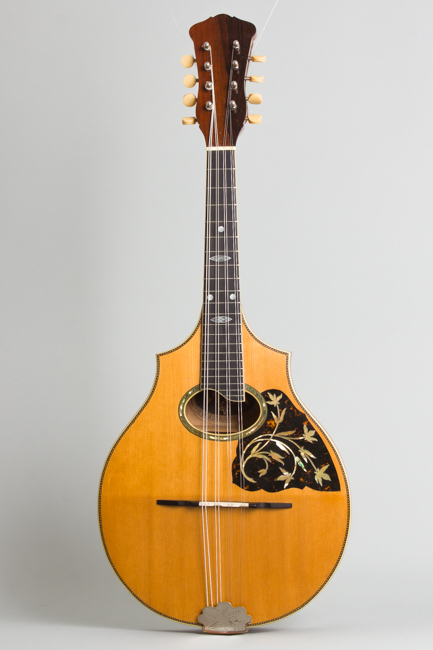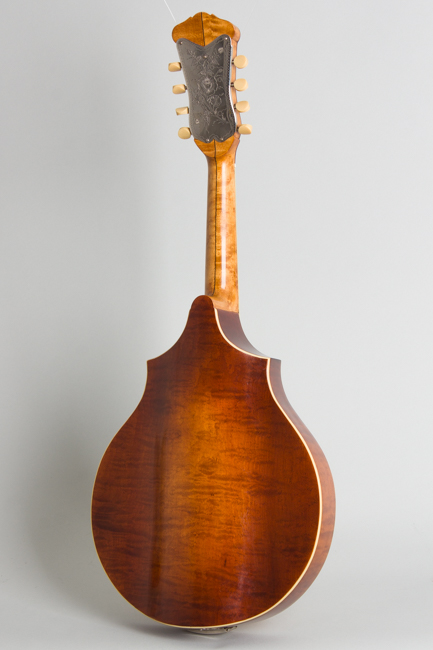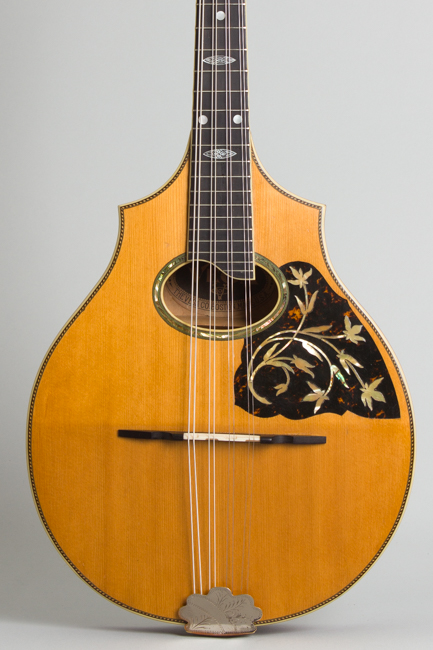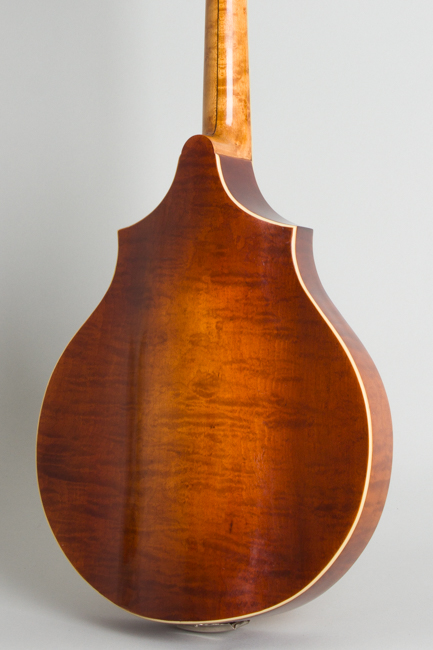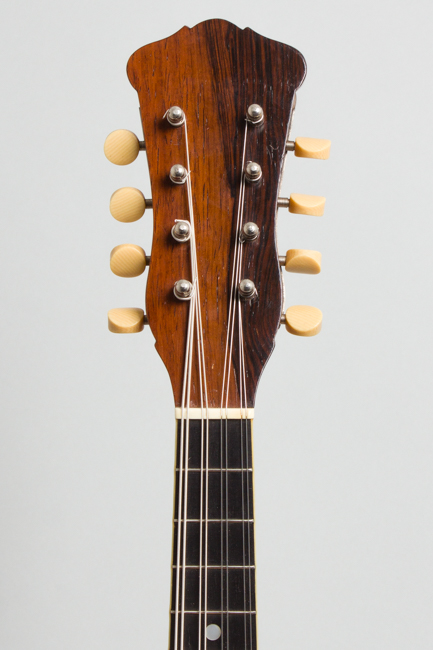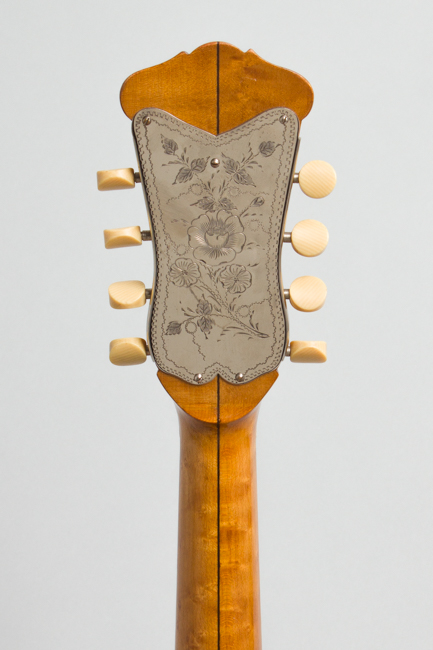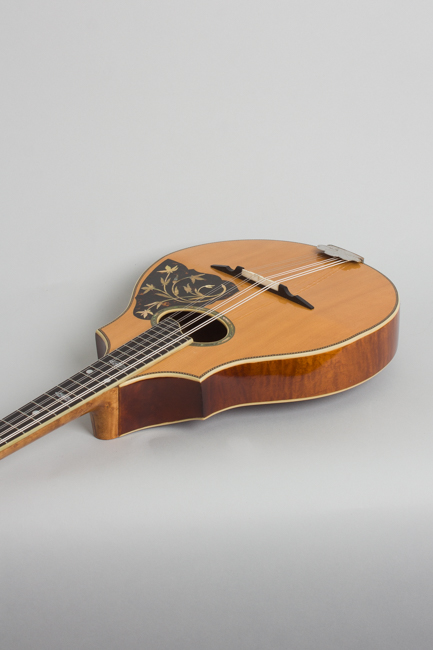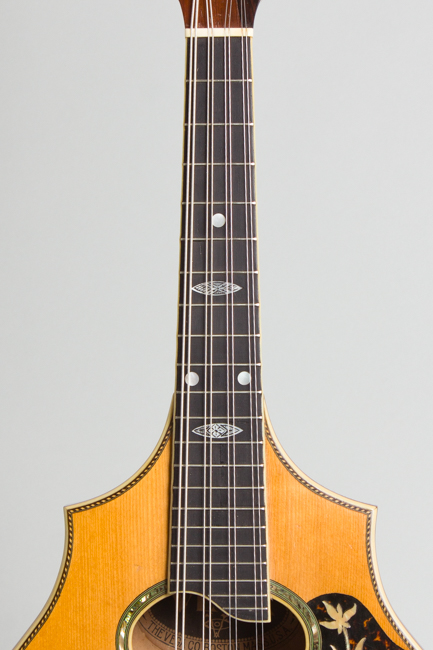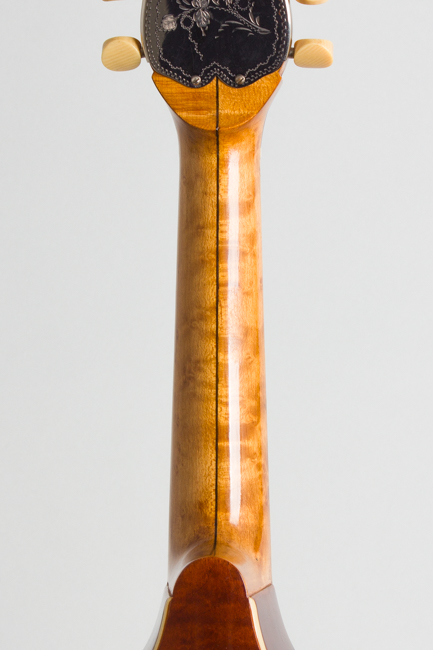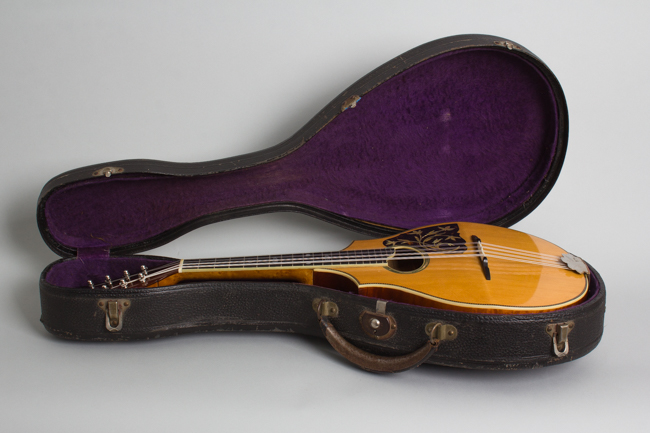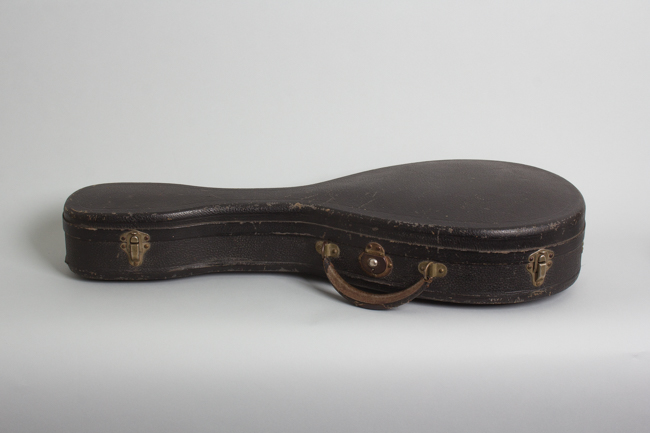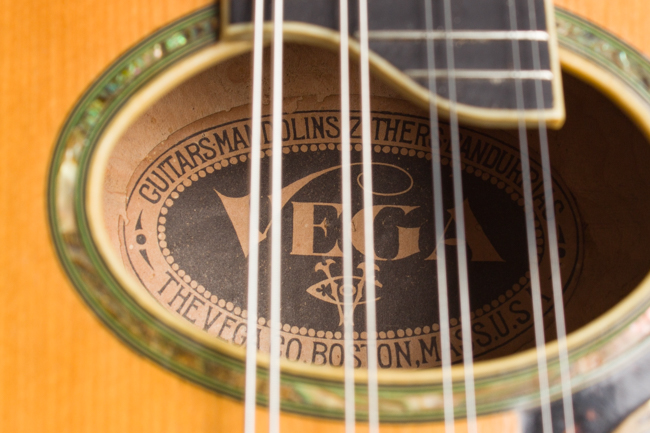Vega Cylinder Back Model 205 Mandolin, c. 1917
Vega Cylinder Back Model 205 Model Mandolin, c. 1917, Boston, Mass., serial # 35404.
The Vega "Lute Mandolins" (or "cylinder-back" as they were later nicknamed) were some of the first major competitors to Gibson's revolutionary carved top mandolins, which by the early 1910s had pretty much upended the bowl-back mando market. A patent for the design was issued on November 4, 1913 to David L. Day, the chief engineer of stringed instruments at the Vega Company in Boston. Day had come to Vega with the purchase of the Fairbanks banjo operation in 1904; he is credited with practically all the design features of not only the world-beating Fairbanks and Vega banjos but the subsequent 1920s Bacon & Day banjo models as well. He was likely also largely responsible for this instrument's original if ultimately mostly forgotten design.
"Cylinder back" refers to a raised cylindrical spine running down the back of the mandolin from the neck heel to the tailpiece. This increases the internal volume of the body compared to the more conventional bent top, flat back mandolins coming into favor at the time, theoretically resulting in a combination of the best sonic characteristics of Neapolitan-style bowlback mandolins with the easier handling and more modern feel of the then-new flat backs. "The Vega Lute Mandolins are praised by the artist and connoisseur for their pure, clear tone and carrying power" the company intoned "It is our aim to keep the Vega standard for experts".
Vega started manufacturing these "Mando-Lutes" around 1913 and they were built (likely in ever-in decreasing numbers) well into the 1920s. Vega followed Gibson in creating a complete orchestral set including not only a mandola, mandocello and mando-bass but unusual hybrid 10-string models. All are rare today; although passingly popular for a time they never seriously challenged Gibson's dominance of the mandolin orchestra market, a fate shared with the higher-end Lyon & Healy and Bacon branded mandolins. While never catching on with country or Bluegrass players cylinder-back Vegas are still played and collected by mandolinists of classical and orchestral bent and also purely for their beauty and superb quality.
Everything Vega built in this period is made to an extremely high quality standard, rivaled only by Martin. This Model 205 was next to top of the "Mando-Lute" line; the next-up 207 was largely the same but added pearl trim around the top and more fingerboard inlay. This 205's serial number puts the manufacture date around 1917-8; there is no fully reliable source for Vega mandolin serial numbers. The Style 205 has a maple body and a very fine-grained spruce top, bound in ivoroid and bordered with half-herringbone marquetry and a green abalone soundhole ring. The pickguard is inlaid into the top, with inset pearl in the same floral pattern as Martin used for their OM-45 Deluxe some years later.
The 3-piece laminated figured maple neck has a flat radius, bound ebony fretboard with mixed dot and shaped engraved pearl inlay. The headstock is faced in rosewood with inset bowlback style tuners under an engraved backplate. The carved bridge is ebony with a bone insert, the tailpiece has a fancy engraved "clamshell" cover. This Model 205 is a splendid example; all finish and hardware are original and it is an excellent playing and sounding mandolin with a sweet singing tone, more powerful than one might expect. This is the nicest "cylinder back" we have ever had, a lovely instrument in every way.
Overall length is 24 3/4 in. (62.9 cm.), 10 in. (25.4 cm.) across at the widest point, and 2 in. (5.1 cm.) in depth, measured at side of rim. Scale length is 13 3/4 in. (349 mm.). Width of nut is 1 1/8 in. (29 mm.).
This rare Vega is an amazingly all original, super clean and 100% intact and unaltered instrument that appears not much used over nearly 110 or so years. There are small play and handling marks overall, most notably shallow pick scrapes and dinks mostly to the top, but really no serious wear. All finish, fittings and hardware are original and the mandolin is an excellent player with a lovely transparent but surprisingly powerful sound. This Vega is basically as fine as we generally expect to see instruments of this vintage, still in a relatively clean original case. Overall Excellent Condition.
The Vega "Lute Mandolins" (or "cylinder-back" as they were later nicknamed) were some of the first major competitors to Gibson's revolutionary carved top mandolins, which by the early 1910s had pretty much upended the bowl-back mando market. A patent for the design was issued on November 4, 1913 to David L. Day, the chief engineer of stringed instruments at the Vega Company in Boston. Day had come to Vega with the purchase of the Fairbanks banjo operation in 1904; he is credited with practically all the design features of not only the world-beating Fairbanks and Vega banjos but the subsequent 1920s Bacon & Day banjo models as well. He was likely also largely responsible for this instrument's original if ultimately mostly forgotten design.
"Cylinder back" refers to a raised cylindrical spine running down the back of the mandolin from the neck heel to the tailpiece. This increases the internal volume of the body compared to the more conventional bent top, flat back mandolins coming into favor at the time, theoretically resulting in a combination of the best sonic characteristics of Neapolitan-style bowlback mandolins with the easier handling and more modern feel of the then-new flat backs. "The Vega Lute Mandolins are praised by the artist and connoisseur for their pure, clear tone and carrying power" the company intoned "It is our aim to keep the Vega standard for experts".
Vega started manufacturing these "Mando-Lutes" around 1913 and they were built (likely in ever-in decreasing numbers) well into the 1920s. Vega followed Gibson in creating a complete orchestral set including not only a mandola, mandocello and mando-bass but unusual hybrid 10-string models. All are rare today; although passingly popular for a time they never seriously challenged Gibson's dominance of the mandolin orchestra market, a fate shared with the higher-end Lyon & Healy and Bacon branded mandolins. While never catching on with country or Bluegrass players cylinder-back Vegas are still played and collected by mandolinists of classical and orchestral bent and also purely for their beauty and superb quality.
Everything Vega built in this period is made to an extremely high quality standard, rivaled only by Martin. This Model 205 was next to top of the "Mando-Lute" line; the next-up 207 was largely the same but added pearl trim around the top and more fingerboard inlay. This 205's serial number puts the manufacture date around 1917-8; there is no fully reliable source for Vega mandolin serial numbers. The Style 205 has a maple body and a very fine-grained spruce top, bound in ivoroid and bordered with half-herringbone marquetry and a green abalone soundhole ring. The pickguard is inlaid into the top, with inset pearl in the same floral pattern as Martin used for their OM-45 Deluxe some years later.
The 3-piece laminated figured maple neck has a flat radius, bound ebony fretboard with mixed dot and shaped engraved pearl inlay. The headstock is faced in rosewood with inset bowlback style tuners under an engraved backplate. The carved bridge is ebony with a bone insert, the tailpiece has a fancy engraved "clamshell" cover. This Model 205 is a splendid example; all finish and hardware are original and it is an excellent playing and sounding mandolin with a sweet singing tone, more powerful than one might expect. This is the nicest "cylinder back" we have ever had, a lovely instrument in every way.
Overall length is 24 3/4 in. (62.9 cm.), 10 in. (25.4 cm.) across at the widest point, and 2 in. (5.1 cm.) in depth, measured at side of rim. Scale length is 13 3/4 in. (349 mm.). Width of nut is 1 1/8 in. (29 mm.).
This rare Vega is an amazingly all original, super clean and 100% intact and unaltered instrument that appears not much used over nearly 110 or so years. There are small play and handling marks overall, most notably shallow pick scrapes and dinks mostly to the top, but really no serious wear. All finish, fittings and hardware are original and the mandolin is an excellent player with a lovely transparent but surprisingly powerful sound. This Vega is basically as fine as we generally expect to see instruments of this vintage, still in a relatively clean original case. Overall Excellent Condition.
